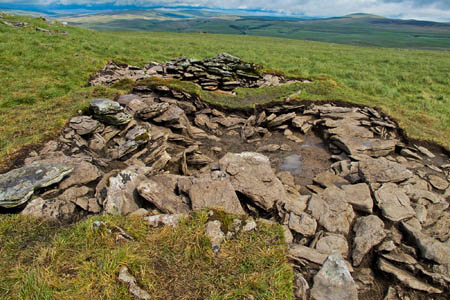
The Anglo-Saxon house uncovered on the flanks of Ingleborough above Selside. Photo: Yorkshire Dales National Park Authority
A group of amateur archaeologists have unearthed an ancient dwelling on the flanks of one of Yorkshire’s Three Peaks.
The site is the first in the Yorkshire Dales national park to be positively identified as a 7th century home.
Carbon dating of artefacts found on the hillside, west of Selside in Ribblesdale, has confirmed them as Anglo-Saxon.
The building, on Ingleborough’s eastern slopes, is one of the first from that date to be discovered in the North of England.
The discovery came after members of the Ingleborough Archaeology Group spent weeks investigating a remote site.
Excavation supervisor Dr David Johnson said: “We uncovered a small, rectangular, partly stone-built building with two rooms and in it we found 16 pieces of charcoal impressed into the compacted soil floor.
“Two of these were sent for radiocarbon dating and returned identical dates – between AD660 and 780, which puts the end of the site’s use firmly within the Anglo-Saxon period. That makes this building the only firmly dated, post-Roman archaeological site in Ribblesdale – which is of more than local significance.
“We also found small pieces of chert, a dark, rock-like flint that was knapped to make small tools. These are likely to date from the early Neolithic period, possibly 6,000 years ago and it was probably pure chance that the pieces found their way into the building – they may have been trapped in turfs used for sealing the walls or roof of the building.”
Robert White, the Yorkshire Dales National Park Authority’s senior historic environment officer, said: “The group is one of the organisations we frequently give grants to carry out to support fieldwork projects and encourage research
“This is an exciting discovery and one which is a credit to the group for the professional way they approached and conducted the excavation.
“The national park has a wealth of archaeological sites but very few have been excavated and even fewer since scientific dating techniques became widely available.
“This is the first building in the national park that is firmly dated to the 7th century and is one of only a handful in the north. “The results help fill in a picture of how life and farming communities developed in the Dales and shows just how much unrecorded archaeology there still is.
“Although very little written information survives for the period between the ending of Roman occupation in about AD410 and the Norman Conquest, archaeological evidence has shown it to be a culturally rich and politically dynamic period across many areas of the country.”
Many settlement sites have been identified between Ribblehead and Horton in Ribblesdale, including a well known site near Ribblehead Quarry that was excavated in the 1970s.
Roger Bingham, the national park authority’s member champion for conservation of cultural heritage, said: “All of us who are concerned about conserving and discovering more of our heritage have to thank enthusiasts for their important discoveries.
“They are only ‘amateur’ because they are unpaid. In every other way – in methods of working and, above all, in recording – their expertise is thoroughly professional and we are pleased to have been able to provide financial support towards some of their expenses, such as carbon dating, through our research budget.
“In these recent cases they have expanded our knowledge about the dawn of human inhabitation by the first Stone Age Dales people. Their post Roman and Anglo-Saxon discoveries have shed light on a generally unrecorded era and have so helped to illuminate a period once inaccurately called The Dark Ages.”
The site has now been backfilled and the turf reinstated to protect it.
More details about the Dark Ages and Anglo-Scandinavian timelines can be found on the authority’s Out of Oblivion website. There is also an illustrated blog about the excavation on the archaeology group’s website.